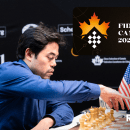GM Magnus Carlsen
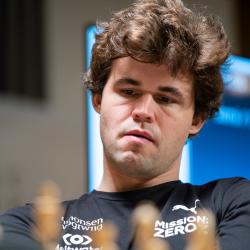
Bio
To many, GM Magnus Carlsen is the best to ever play the game, although GMs Garry Kasparov and Bobby Fischer remain in the conversation. At any rate, the clear and remarkable point is that before turning 30 years old, Carlsen had already earned a spot at the top, and he has continued to dominate into his 30s.
The 13-year-old Norwegian prodigy drew Kasparov and defeated GM Anatoly Karpov at the same event in 2004, one month before he became the second-youngest GM in history (and still eighth-youngest as of 2021). In 2009, he became the youngest player to break the 2800-rating threshold (a record only broken by GM Alireza Firouzja in 2021).
Then Carlsen transitioned from young world-class player to all-time great. He captured the world number-one ranking in 2011 and still hasn’t let go of it as of May 2023. He won the world title in 2013 and has successfully defended it four times (2014, 2016, 2018, and 2021). Additionally, he has won multiple world titles in rapid and blitz time controls, achieved the highest rating ever, and racked up several elite tournament wins, including four Norway Chess victories and seven in Wijk aan Zee.
The amazing part is it seems like there’s much more ahead for Carlsen. In October 2020 Carlsen's 125-game undefeated streak came to an end (he scored 42 wins and 83 draws during this streak), setting yet another world record. If he continues performing the way he has, Carlsen could create something truly legendary.
In an era of chess that’s more competitive than ever, he’s far ahead of the opposition. This despite voluntarily relinquishing the world championship in 2023, the first player to do so since Fischer. Carlsen further established his continued dominance by winning the 2023 Champions Chess Tour.
- Youth (1995 To 2004)
- The Second-Youngest GM In History (2004 To 2009)
- The Youngest 2800 In History (2009 To 2012)
- The 16th Undisputed World Champion (2013)
- Achieving 2882 And World Titles In All Time Controls (2014 To 2022)
- Post World Championship (2023 To Present)
Youth and Early Chess Career (1995 To 2004)
Carlsen learned how to play chess when he was five years old. However, he didn’t show much interest at first. He instead amazed other people by completing activities that demonstrated his general intellectual aptitude at an early age.
At two years of age, Carlsen could solve 50-piece jigsaw puzzles. He also played with Lego sets intended for children 10 to 14 years old. When Henrik Carlsen, his father, introduced him to chess, the five-year-old was busy memorizing the areas, population numbers, flags and capitals of every country in the world. Later Carlsen completed a similar task—memorizing areas, population numbers, coat-of-arms and administrative centers—for nearly all Norwegian municipalities (there are 422 municipalities today).
Carlsen's impressive memory helped as he became more interested in chess. Initially, he simply wanted to beat his oldest sister. But soon he was replaying games that his father had showed him, practicing combinations while playing against himself and reading chess books. His first book was Find the Plan from GM Bent Larsen, the six-time Danish champion and the strongest-ever Scandinavian player—before Carlsen.
Early in his chess career, Carlsen was coached by Norway’s top player, the seven-time national champion GM Simen Agdestein, who with former Norwegian junior champion Torbjorn Ringdal Hansen helped Carlsen hone his talent quickly. In one year (2000), his rating increased more than 1000 points, from 904 to 1907.
It didn’t take long for Carlsen to rack up impressive performances and tournament wins. In July 2000, the nine-year-old won the youngest age group at the Norwegian championship—for players under the age of 11—with a score of 10/11. Shortly thereafter, he took part in a couple of events and scored a performance rating of about 1900 in one.
Then his breakthrough performance came, according to Carlsen and his family. At the Norwegian championship for junior teams in September 2000, he scored 3.5 out of 5 against the country’s top players. Still just nine years old, Carlsen achieved a rating performance of about 2000 in the event.
In 2002 Carlsen continued his upward trajectory. He placed sixth in the Under-12 section of the European Youth Chess Championship, and a few weeks later he tied for first place in the World Youth Chess Championship’s Under-12 section. However, in tiebreaks he lost to GM Ian Nepomniachtchi, who took the title.
One year later, Carlsen finished in the top 10 for the same two tournaments (European and World Youth Chess Championship) in the Under-14 sections. He secured three IM norms that year, at the age of 12, to claim his IM title in August 2003.
The Second-Youngest GM In History (2004 To 2009)
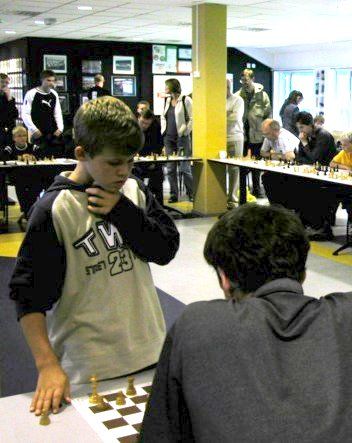
The Norwegian phenom became well-known on the world stage after his successful year in 2004. Carlsen began by winning the C group at the elite Corus tournament in Wijk aan Zee. He went 10.5/13 and had a tournament performance rating of 2702. It was good enough for his first GM norm, and his performance made headlines and led to a Microsoft sponsorship.
After obtaining his second GM norm one month later, Carlsen took part in a blitz tournament in Iceland. There he defeated Karpov, the former world champion and often recognized as one of the top 10 players of all time. The next day, in the subsequent rapid knockout event, the 13-year-old was paired with Kasparov, then the number-one player in the world.
Remarkably, Kasparov was fortunate to escape with a draw. Carlsen had a commanding position but faced time trouble. Carlsen lost the next game against Kasparov, but his battles against two of the greatest players to play chess were widely publicized.
The next month, in April, Carlsen got his third and final GM norm. At 13 years, four months and 27 days of age, Carlsen became the youngest grandmaster in the world and the second-youngest grandmaster at the time (after GM Sergey Karjakin, who held the record at exactly 12 years and seven months of age until 2021).
Carlsen played in the Norwegian Chess Championship in 2004 and tied the reigning champion, GM Berge Ostenstad, for first place. A two-game match to decide the title resulted in two draws, and Ostenstad retained his national title because he had the superior tiebreaks in the tournament. The next year Carlsen again tied for first place in the event, this time against his mentor, Agdestein.
However, a change in format meant that the winner couldn’t be decided on superior tiebreaks in the tournament (which Carlsen had), and Agdestein beat Carlsen in the sixth rapid tiebreak game to win the title. Carlsen secured his first Norwegian championship the following year, in 2006, which was the last time he took part in the event.
In 2005 Carlsen took first place at the Arnold Eikrem Memorial with 8/9 points. The 14-year-old finished a full point ahead of more experienced GMs and had a remarkable tournament performance rating of 2792. Later, at the end of 2005, Carlsen placed 10th at the FIDE World Cup to become the youngest player (15 years old) to qualify for a Candidates Tournament. In the first round of the 2007 tournament, he met top-seed GM Levon Aronian. The two were tied at the end of their six slow games, and then Aronian won the match on rapid tiebreaks.
In 2006, Carlsen tied for first at the Bosna Sarajevo tournament. The double round-robin event featured six players with an average rating of 2659. Carlsen, then 15 years old, achieved a 2696 performance rating in the event. He won the Glitnir Blitz tournament that year after sweeping both GMs Viswanathan Anand and Hannes Stefansson in the semifinals and finals, respectively, by a 2-0 margin. At the 37th Chess Olympiad, he scored 6/8 and had the fifth-highest performance rating of the tournament, which hosted 13 2700-rated players and 42 GMs rated higher than Carlsen.
Carlsen once again played in the Biel Grandmaster Tournament in 2007 after finishing in last place in 2005 and second place in 2006. This time Carlsen broke through and secured his first category-18 tournament (average rating range from 2676 to 2700) win. At that time he called it his most important success. Carlsen overcame a field that included four players in the world’s top 25 at the time—GMs Teimour Radjabov (9), Alexander Grischuk (14), Judit Polgar (19), and Bu Xiangzhi (25)—with 6/10 points and a performance rating of 2753.
In the early part of 2008, Carlsen kicked off the year with two performance ratings of over 2800. The first came in the group A of the elite Wijk aan Zee tournament. To say it was a loaded field would be an understatement: Eleven of the 14 players were ranked in the world’s top 16 players, and all but two had a rating of at least 2700. Carlsen, at 17 years old, tied with Aronian for first place despite being ranked 10th in the group.
His second event was another elite event, the Linares tournament, which consisted of just eight players who were ranked in the world’s top 13—Carlsen was number 13. He finished with 8/14 points for clear second place behind the world champion at the time, Anand. Another highlight in 2008 was Carlsen’s win at the Aerosvit tournament, where he finished undefeated at 8/11 points and achieved his best performance rating of his career at 2877.
The Youngest 2800 In History (2009 To 2012)
In September and October 2009, Carlsen had one of his best performances at the Pearl Spring Chess Tournament. The annual tournament, held from 2008 to 2010, was a double round-robin event that featured six super grandmasters.
Carlsen won the 2009 tournament with 8/10 points, finishing 2.5 points ahead of the top-rated player in the world at the time, GM Veselin Topalov. But the real story is Carlsen’s tournament performance rating—3001. That’s the fourth-highest performance rating in a tournament since the Elo rating system was established in 1970. At the time, chess statistician Jeff Sonas ranked it against all events in history. He deemed it one of the 20 top tournament performances of all time and the best of all time by a teenager.
The 18-year-old, 2772-rated Norwegian prodigy boosted his rating by 29 points by winning the Pearl Spring Chess Tournament in spectacular fashion, giving him a new rating of 2801. It made him just the fifth player in history to break 2800 and the youngest to do so until Firouzja in 2021.
In November, the following month, Carlsen won the World Blitz Championship Tournament. It was by no small margin, either. He scored 31/42 points, three full points ahead of the current world champion (classical) at the time, Anand, who was three points ahead of another world champion, GM Vladimir Kramnik (who shared third place with Karjakin). The tournament was a double round-robin event with 22 players and an average rating of 2718. Carlsen, just two weeks before his 19th birthday, became the world champion in blitz with a performance rating of 2894.
Carlsen’s remarkable 2009 ended with the London Chess Classic, a strong invitational tournament for the world’s top grandmasters. Using a different scoring system—three points for a win, one for a draw and zero for a loss—Carlsen, the number-one player in the world, won with 13 points. He didn’t lose a single game and had three wins in the seven-round event, including one against Kramnik, the second-highest rated player in the tournament.
It looked like 2010 would bring more of the same. In January, Carlsen won the annual elite tournament in Wijk aan Zee with 8.5 out of 13 points. The field had an average rating of 2719 and included GMs Kramnik, Alexei Shirov, Anand, and Hikaru Nakamura. In June, Carlsen won Bazna Kings 2010, going undefeated with 7.5/10 and a 2918 performance rating. He won the tournament two full points ahead of GMs Radjabov and Boris Gelfand.
Then Carlsen suffered a setback. At the Grand Slam Masters Final in October, he faced Kramnik, Anand, and Shirov in a four-player tournament that had an average rating of 2789—the highest-rated event in history at the time. Carlsen suffered two losses and finished third, achieving a performance rating of only 2719. Rated 2826 coming into the tournament, Carlsen dropped to 2802 following the event, and he lost his grip on being the world’s number-one player. Anand, rated 2804, took the top spot.
Next for Carlsen was the 2010 Pearl Spring Chess Tournament, which took place days after the Grand Slam. Carlsen silenced critics who said he was distracted from chess by activities such as modeling. In the only tournament of the year featuring the top three players in the world—Anand, Carlsen and Topalov—Carlsen finished in first with 7/10 points, one point in front of Anand.
In November 2010, Carlsen withdrew from the world championship cycle. He qualified as the highest-rated challenger but didn’t believe that there was a “sufficiently modern and fair” system in place, he wrote in a letter to FIDE. “Reigning champion privileges, the long (five year) span of the cycle, changes made during the cycle resulting in a new format (Candidates) that no World Champion has had to go through since Kasparov, puzzling ranking criteria, as well as the shallow ceaseless match-after-match concept, are all less than satisfactory in my opinion.”
Carlsen ended the year with a third-place finish in the World Blitz Championship and another win at the London Chess Classic, which was billed as the U.K.’s strongest-ever chess tournament. By two points, Carlsen topped a field with an average rating of 2725, including GMs Anand, Luke McShane, Nakamura, and Kramnik.
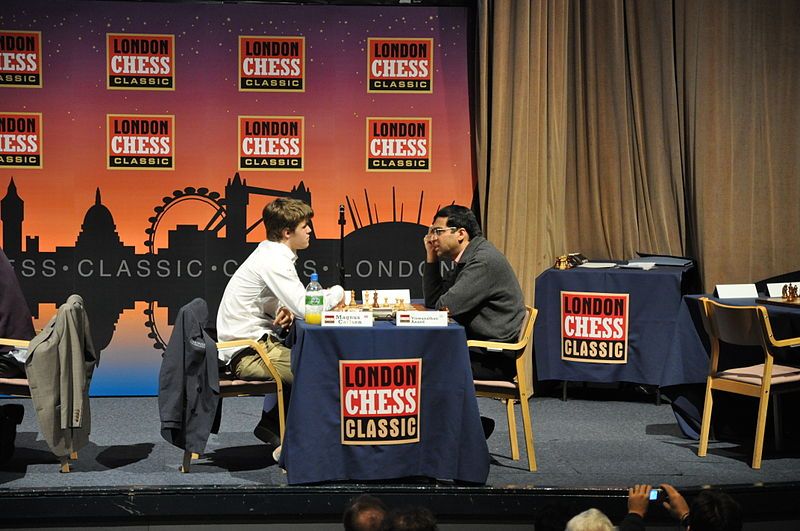
After a tie for third place in January at Wijk aan Zee, Carlsen put together a handful of major tournament victories in 2011. He beat Karjakin on tiebreaks to win Bazna Kings 2011. Then at the 44th Biel Chess Festival, he scored 19/30 points to win comfortably ahead of GM Alexander Morozevich, who finished with 17/30. A couple of months later, Carlsen beat GM Vassily Ivanchuk in blitz tiebreakers to take the Grand Slam Chess Final. His final tournament victory that year was in December at the Tal Memorial, where he finished ahead of Aronian on tiebreaks.
The highlight that year wasn’t Carlsen’s tournament performances, which were impressive given the world-class competition in each event. It’s that he recaptured the world number-one position. In FIDE’s ratings list for July 2011, Carlsen overtook Anand. And since that time, Carlsen has remained the highest-rated player in the world. (At the time of publishing, Carlsen has spent 112 months at number-one, second in history to only Kasparov.)
Carlsen had another good year in 2012. At Wijk aan Zee (Tata Steel 2012), he finished behind Aronian in a second-place tie with GMs Radjabov and Fabiano Caruana. Another second-place finish came at the Biel Grandmaster Tournament, this time behind GM Wang Hao.
Then came two wins. At the Grand Slam Chess Final, Carlsen won first place after beating Caruana in blitz tiebreaks 2-0, finishing ahead of the talented American as well as Aronian, Anand, and Karjakin. Finally, in December, Carlsen won the 2012 London Chess Classic, his third win at the tournament. He finished ahead of a star-studded field that included GMs Kramnik, Michael Adams, Nakamura, Anand, Aronian, and Polgar.
After his performance at the London Chess Classic, Carlsen broke Kasparov’s 13-year-old rating record (2851). In January 2013, it was official in FIDE’s ratings list. Carlsen had earned a rating of 2861—the highest ever.
The 16th Undisputed World Champion (2013)
Carlsen started 2013 with another win in Wijk aan Zee. With 10/13 points, equaling Kasparov’s record score in the 1999 tournament, Carlsen finished 1.5 points ahead of second-place Aronian. The number-one player in the world also had a couple of second-place finishes at the inaugural Norway Chess 2013 tournament and the Tal Memorial. In September, Carlsen finished a point ahead of Nakamura in his Sinquefield Cup win.
One month later, Carlsen would face the world champion at the time, Anand, for the most important title in chess. Previously, though, in March and April, Carlsen had competed in the 2013 Candidates Tournament and won the event on tiebreaks over the world’s number-two player at the time, Kramnik. That set the stage for Carlsen vs. Anand in the World Chess Championship 2013 in Chennai, India. Carlsen was rated 2870 while Anand, number-eight in the world, was rated nearly 100 points lower at 2775.
The first four games resulted in draws. Then, in the fifth game, Carlsen castled queenside on the white side of a Marshall Gambit sideline. With better piece activity and pawn structure, Carlsen kept the pressure on Anand, who had missed a key move in a rook-and-bishop endgame to keep the balance (45. … Ra1). Carlsen took the first decisive result in the match, and his momentum continued in the next game. As Black, the world’s top-rated player capitalized on the reigning world champion’s mistakes in a rook-and-pawn endgame. After six games, halfway through the match, Carlsen took a commanding 4-2 lead.
The next two games were relatively quiet. In game seven, Carlsen defended well as Black in the Berlin Defense of the Ruy Lopez, leading to a draw. And then, in game eight, Carlsen opted for 1. e4 for the first time, which caught Anand by surprise. Anand took criticism for playing the quiet Berlin Defense, which led to piece trades and a symmetrical position, resulting in another draw.
Given the match situation, Anand vowed to play more aggressively in the next game. He played a sharp line against the Nimzo-Indian (4. f3), and an exciting game ensued. Anand missed chances for a better attack while Carlsen defended well. A late blunder forced from Anand led to a lost game, and the match was practically beyond reach. The 10th game ended in a draw to close the match by a score of 6.5-3.5.
Carlsen became the world champion of chess roughly one week before his 23rd birthday. Ending Anand’s reign as the undisputed champion from 2007 to 2013, Carlsen became the 16th undisputed world champion. He celebrated by jumping fully clothed into a pool.

Carlsen’s dynamic play made his match with Anand one to remember. Chess.com named it seventh on the list of the 10 most exciting world championships of all time.
Achieving 2882 And World Titles In All Time Controls (2014 To 2022)
After achieving the most recognizable and important accomplishment in chess, Carlsen somehow upped the ante the following year in 2014. He started by winning the Zurich Chess Challenge 2014, which at the time was the highest-rated tournament in history. With an average rating of 2801, the event qualified for the first-ever category-23 tournament (2801 to 2825). A preliminary blitz event, which Carlsen won, determined the draw.
Then it was time for classical chess. Carlsen scored eight points in that portion, two points ahead of Aronian. A rapid portion concluded the event, which Carlsen finished in fourth place, but overall, it was enough for a full-point win ahead of second-place finishers Caruana and Aronian. Other participants were Nakamura, Anand, and Gelfand.
Later in April, Carlsen won the Shamkir Chess 2014 tournament. He finished with 6.5/10 points and one full point ahead of Caruana, who finished in second. The next month, on the May 2014 FIDE ratings list, Carlsen made history. He achieved his highest official rating of 2882. Earlier during the Shamkir event, his live rating hit 2889.2 on April 21, 2014. Both are the highest ratings ever achieved in classical chess.
Carlsen wasn’t done in 2014. In June, the FIDE World Rapid & Blitz Chess Championships took place in Dubai. Carlsen scored 11/15 points to win the world rapid championship half a point ahead of Caruana, Anand, Aronian, and Morozevich. Two days later, Carlsen scored 17/21 points to take the world blitz championship—a full point ahead of Nepomniachtchi and Nakamura, who finished two points ahead of the rest—and become triple world champion in all three time controls for the first time.
After the feat, Kasparov commented on Twitter: “Carlsen is the strongest, of course, but winning at all 3 time controls is a little like winning tennis slams on clay, grass and hard court.” There was little doubt about the triple world champion’s abilities, but Carlsen had another major event in 2014 with his first (classical) title defense. Anand won the Candidates Tournament and clinched a rematch with Carlsen for the world title.
The first game was a fighting draw with Carlsen on the black side of the Grunfeld Defense. He then took the first win as White in a Ruy Lopez with more active pieces in the endgame. However, Anand returned the favor in game three with a win that was aided by superior opening preparation in a sharp variation of the Queen’s Gambit Declined. The turning point was in game six.
After two draws, Anand missed a simple tactical idea that would have given him strong winning chances. He blundered (after Carlsen had blundered) and lost the game. Four more draws took place as Carlsen enjoyed his one-game lead. Then, in a must-win game 11 for the challenger, Anand managed to complicate the middle game, but it wasn’t enough. Carlsen won the game, clinched the match, and defended his world championship title.
Carlsen kicked off the next year by winning 2015 Tata Steel in Wijk aan Zee. With only one loss and 9/13 points, Carlsen took the event by a half-point over GMs Maxime Vachier Lagrave, Anish Giri, Wesley So, and Ding Liren, all who shared second place. The next month Carlsen won his second of two tournaments after beating GM Arkadij Naiditsch on tiebreaks at the Grenke Classic. The triple world champion then faltered in his next two events. He played poorly at Norway Chess, placing seventh, and had a decent showing at the 2015 Sinquefield Cup, placing second.
In October 2015, it was time for Carlsen to defend his world titles in rapid and blitz time controls. He pulled off the former in convincing fashion, taking the rapid championship one point ahead of GM Leinier Dominguez Perez, Radjabov and Nepomniachtchi. That performance made Carlsen the highest-rated player in all three time controls simultaneously.
However, it was a temporary accomplishment. Carlsen started the blitz tournament’s second and final day tied with Vachier-Lagrave for the lead, but faltered and finished in a tie for sixth place. Grischuk won the world blitz title, and Nakamura overtook Carlsen (who lost 35.6 rating points in the event) as the highest-rated blitz player in the world.
The next wave of tournament chess for Carlsen was dominant. He unleashed a series of victories in several top-level events: the London Chess Classic and the Qatar Masters in December 2015, his fifth title at Wijk aan Zee with an undefeated performance in the 2016 Tata Steel Masters in January, his first title at Norway Chess in April 2016, wins in the rapid and blitz portions (to take the overall tournament) of Leuven for the Grand Chess Tour in June 2016 and Bilbao Masters with a round to spare in July 2016.
In October 2016, Carlsen then won Chess.com’s GM Blitz Battle Championship by beating GMs Tigran Petrosian 21-4, Grischuk 16-8, and Nakamura 14.5-10.5. The final match between Carlsen and Nakamura broke records for viewership and sign-ins on Chess.com.
Next for Carlsen was his second world championship title match defense. His World Chess Championship 2016 test was against Karjakin, who had won the 2015 FIDE World Cup and took out Caruana in the 2016 Candidates Tournament. Draws ensued until the eighth game, when Karjakin drew first blood with a win as Black—Carlsen walked out of his press conference after that game (although only after he was left alone at the dais). In the 10th game, Carlsen evened the score after a lengthy maneuvering game and winning rook endgame.
Two more draws ensued, pushing the match to rapid tiebreaks. In the third tiebreak game, Carlsen turned on the pressure with a strong attack out of the Ruy Lopez. He won this game and played solidly in game four, a must-win for Karjakin, who pushed too hard and blundered, giving Carlsen another win. By winning the rapid playoff, Carlsen defended his world championship title yet again. Chess.com called it the ninth most exciting world championship match of all time.
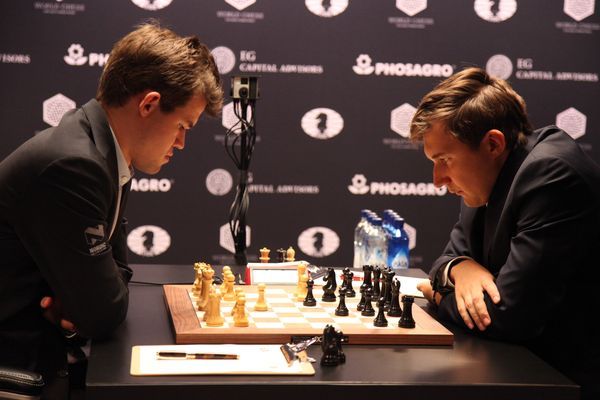
Carlsen had an up-and-down year in 2017. Early he had two second-place finishes in Tata Steel 2017 and the Grenke Chess Classic, followed by a nightmare performance in June 2017 at Norway Chess when he finished ninth out of 10 and received his lowest tournament performance rating (2670) since November 2015. Carlsen then started to improve his performance. He beat Vachier-Lagrave in a playoff to clinch the Paris Grand Chess Tour and then a few days later played in the Leuven Grand Chess Tour.
With a combined rapid and blitz score of 25.5 points, he finished 4.5 points ahead of second-place finishers Giri and Vachier-Lagrave. The key was his blitz performance. Taking 14.5/18 points in blitz, Carlsen's performance was judged “phenomenal” by Kasparov, and the legend was spot-on. Carlsen’s performance rating in the blitz portion was 3018. According to The Guardian chess columnist Leonard Barden, “[O]nly Bobby Fischer’s crushing victory at the world blitz in 1970, where he also outclassed a star field, stands comparison.”
A couple of disappointing performances later (in the Sinquefield Cup and the 2017 World Cup), Carlsen finally captured his first classical tournament win in 435 days by winning the 2017 Chess.com Isle of Man International in October. He finished with 7.5/9 points in the elite tournament, which put him ahead of Anand and Nakamura by a half-point.
In December, Carlsen tied for third in the London Chess Classic, but it was enough to take Grand Chess Tour 2017 due to his performances in the Paris and Leuven legs of the tour. Carlsen’s year ended with the 2017 World Rapid and World Blitz Chess Championships. He had a tough showing in the former, finishing fifth in the World Rapid Chess Championship. However, he reclaimed his title in the World Blitz Chess Championship with a round to spare, topping second-place competitors Karjakin and Anand by 1.5 points.
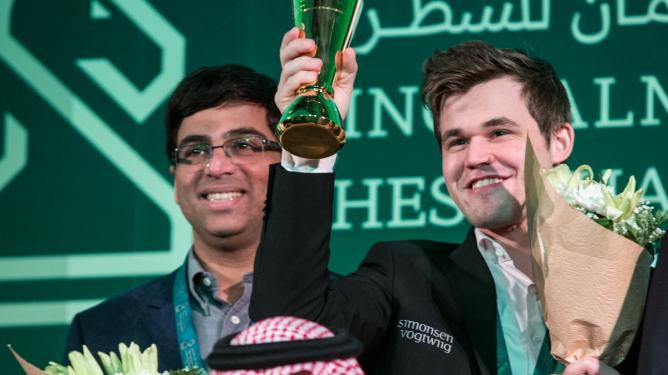
The first matter of business for Carlsen in 2018 was finishing up the 2017 Speed Chess Championship—Chess.com’s second edition of the event. Starting in October 2017, he took down Gadir Guseinov 20.5-5.5, So 27.5-9.5 and Grischuk 15.5-10.5. A few days into January 2018, Carlsen met Nakamura once more in the final and beat him again, this time by a score of 18-9.
Carlsen had a string of impressive performances leading to the world championship events in November and December. They include achieving a record sixth victory in Wijk aan Zee at Tata Steel 2018, winning the unofficial Fischer Random Chess Championship, placing second at the Grenke Chess Classic, winning Shamkir Chess, finishing second at the Biel Chess Festival, and tying for first in the 2018 Sinquefield Cup.
In November, Caruana challenged Carlsen in the World Chess Championship 2018. It was an even fight throughout most of the 12 slow games, which all ended in a draw. In the 12th game, Carlsen was criticized for offering a draw in a better position, but he later explained that he was confident in his ability to win the tiebreaks. The reigning world champion was right. Carlsen won the 2018 World Chess Championship in a playoff after taking all three rapid games. That marked his third successful world title defense.
December marked the time again for the World Rapid and World Blitz Chess Championships. Like the previous year, Carlsen faltered in the former and won the latter. He finished fifth (four-way tie for second) at the 2018 World Rapid Chess Championship and won the 2018 World Blitz Chess Championship with an undefeated score of 17/21 points.
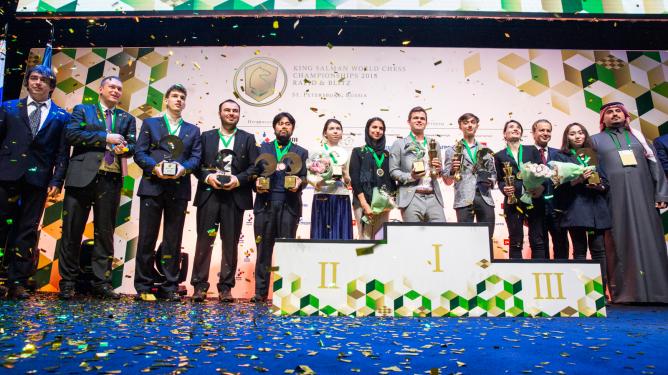
Carlsen started 2019 with, yet again, several impressive performances. He extended his number of titles in Wijk aan Zee to seven with a win at the 2019 Tata Steel Chess Tournament. Then he won the Gashimov Memorial by two full points ahead of the pack, something that hasn’t happened in 4.5 years. Carlsen’s tournament performance was 2988.
Other victories followed, including the Grenke Chess Classic, Côte d'Ivoire Rapid & Blitz, Lindores Abbey Chess Stars Tournament, Norway Chess, and Croatia Grand Chess Tour. The final victory marked Carlsen’s eighth straight tournament win and as a result of his strong play, the world’s number-one returned to his highest rating of 2882 officially in August 2019. At the end of 2019, he was again the world champion for all three time controls (classical, rapid, and blitz).
From there, Carlsen continued to dominate the highest level of chess. Victories in elite tournaments are expected of him, and for the most part, he performs to the incredibly high expectations of the chess world and casual observers. His accomplishments are so impressive that it’s becoming difficult to imagine what’s next for the young chess legend.
Carlsen achieved another noteworthy accomplishment in 2019—a 101-game unbeaten streak set at the 2019 FIDE Chess.com Grand Swiss. Carlsen extended this streak to 125 games, before being defeated by GM Jan Krzysztof-Duda at the 2020 Norway Tournament, to add yet another record to Carlsen’s collection: the longest unbeaten streak in history.
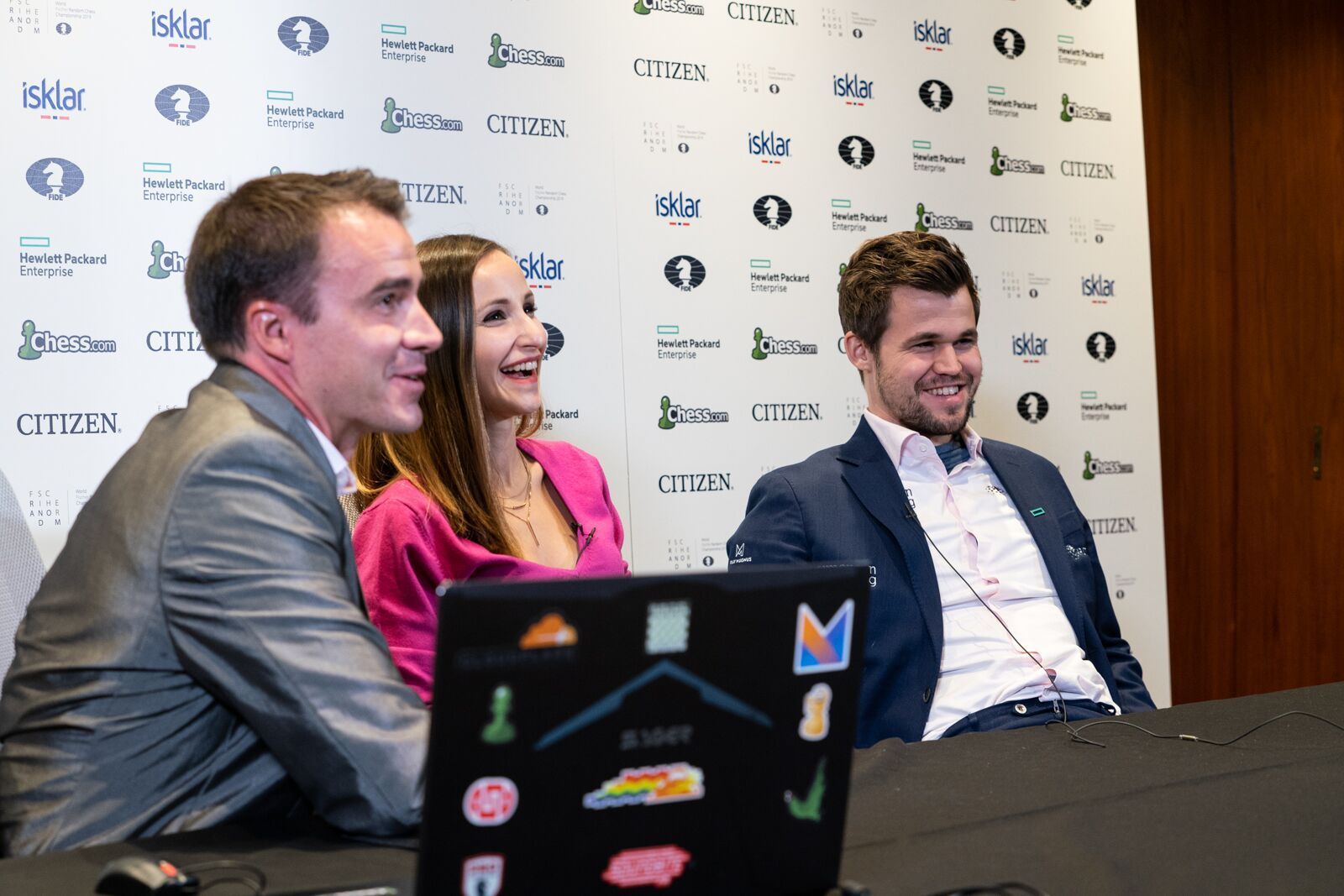
In the spring of 2020 Carlsen announced the Magnus Carlsen Chess Tour, a series of five online tournaments consisting of world-class players and a $1 million prize fund. The tour had four high-profile events (Carlsen won three of these events), and then the Finals for the four highest-scoring players. In the Finals, Carlsen narrowly defeated Nakamura on day seven in the last game by holding a draw with Black in the armageddon game. Despite the close match in the Finals, Carlsen yet again proved that he is the most dominant player on the planet.
2021 was no less an eventful year for Carlsen. He won an expanded, ten-event version of his online tournament series, now called the Champions Chess Tour; finished third at the FIDE World Cup while winning most of his matches (including the third-place match against GM Vladimir Fedoseev) in 2-0 whitewashes; came back from trailing early to win Norway Chess, his fourth victory there; and, most significantly, had his most convincing World Chess Championship match result yet: a 7.5-3.5 victory over GM Ian Nepomniachtchi, which also gave Carlsen a lifetime winning score against one of the few players who could previously have been said to have his number.
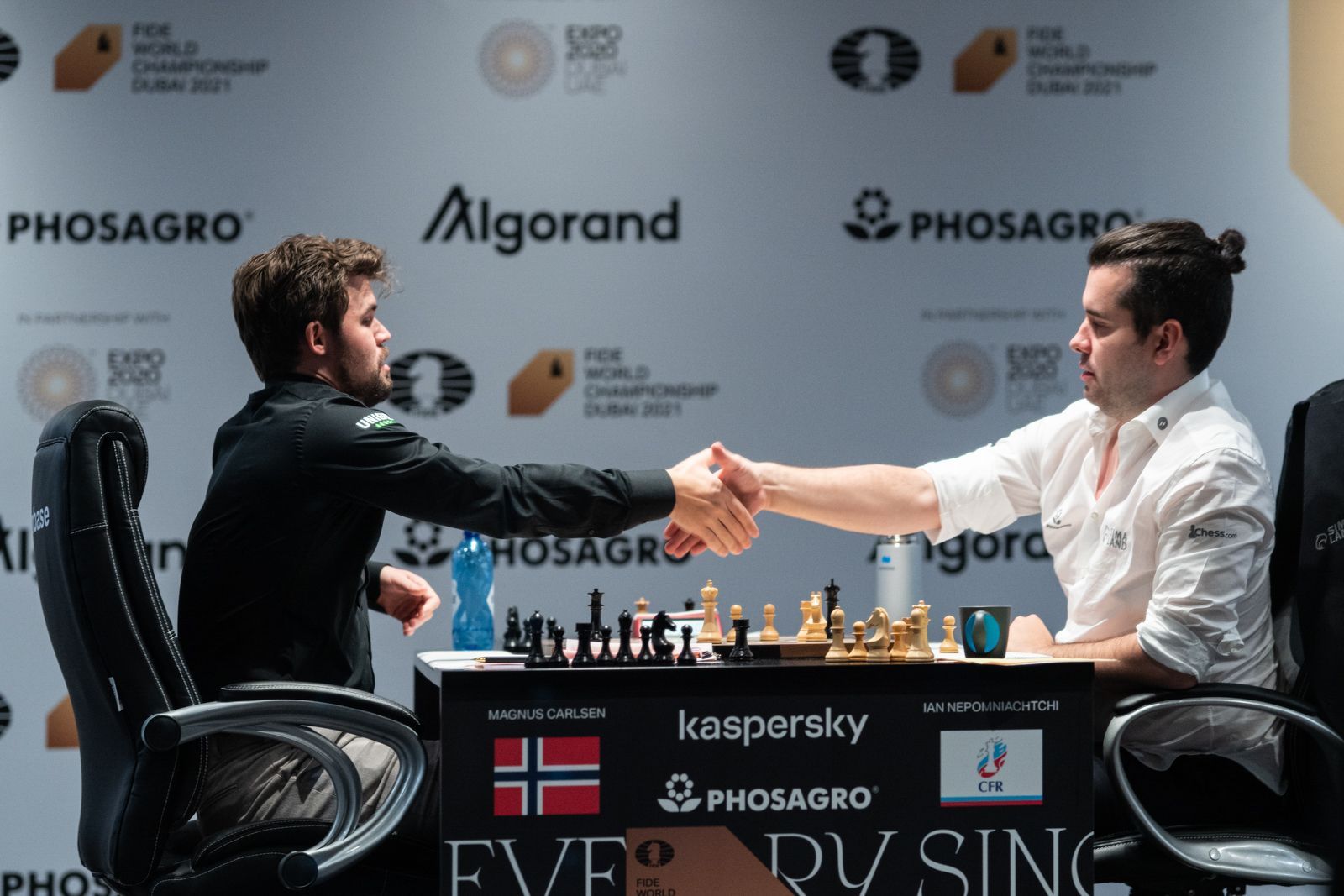
In 2022, Carlsen only added to his resume, despite also announcing that he would no longer pursue the classical world championship. He won Norway Chess and, for the second straight year, the Champions Chess Tour. He also swept the World Rapid and Blitz Championships, the fourth and sixth of his career, respectively.
Post World Championship (2023-present)
Carlsen officially gave up the world champion title once Ding Liren defeated Nepomniachtchi in the 2023 FIDE World Championship. Carlsen won his first event after doing so, the Superbet Rapid & Blitz Poland tournament in the Grand Chess Tour.
In December, he won his third consecutive Champions Chess Tour, the first one held by Chess.com. Carlsen defeated Caruana in the semifinals and So in the finals. Carlsen then won his fifth FIDE World Rapid Championship and seventh World Blitz later that month, sweeping both for the second straight year.
In July 2023 alone, Carlsen won the Grand Chess Tour Croatia and Aimchess Rapid and the runner-up of his first ever Bullet Chess Championship.
In August, he won his first FIDE World Cup in five tries, the last major accomplishment in classical chess that he had yet to achieve. The result technically qualified him to play in the 2024 Candidates Tournament, but he unsurprisingly declined the invitation.
Chess? pic.twitter.com/Vm2wOtC9zn
— Magnus Carlsen (@MagnusCarlsen) August 24, 2023
Carlsen also won the Julius Baer Generations Cup in September 2023. Later that month, he won the 2023 Speed Chess Championship, his third, which ended a five-year streak of Nakamura victories.
In February 2024, Carlsen won the 2024 Chessable Masters, the first leg of the 2024 Champions Chess Tour. Later that month he won the Freestyle G.O.A.T. Challenge.
Even without the official world champion title any longer, Carlsen has accomplished so much in so little time and still he seems ready for more. What does that look like? Perhaps more world titles across blitz and rapid as well as emerging forms of chess like Fischer Random; more titles in elite tournaments like Wijk aan Zee and Norway; more time spent as the top-rated player in the world.
Maybe he’ll surpass the 2882 mark he set as the highest chess rating in history. Whatever the case may be, the world may be witnessing how Carlsen makes his case as the best chess player to play the game.
(Can you play like Carlsen? See if you can come up with his moves in some of his best games.)
